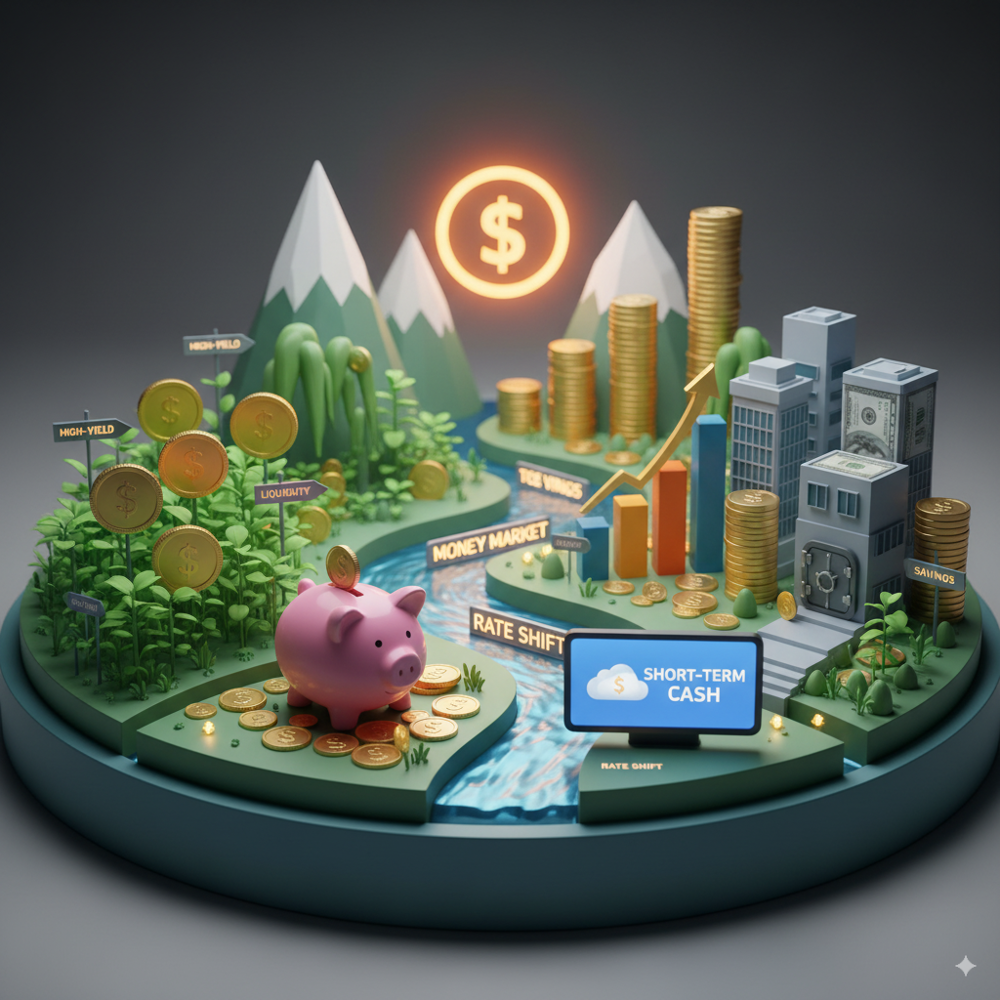В сентябре 2025 года, после того как Федеральная резервная система снизила базовую ставку на 25 базисных пунктов (до диапазона 4,00 %–4,25 %), многие сбережатели столкнулись с неопределённостью. Такое решение, как ожидается, вызовет постепенное снижение ставок, которые банки и кредитные союзы предлагают по сберегательным счетам, денежно-рыночным счетам (MMAs), а также по депозитам с фиксированным сроком (CDs).
Тем не менее, текущие доходности всё ещё исторически высоки, и для тех, кому нужны деньги в течение короткого срока, есть несколько конкурентных и низко-рисковых вариантов. Ниже приведён гид, помогающий выбрать лучшее место для размещения краткосрочных сбережений: обзор ставок, на что обращать внимание и как максимизировать доход при сохранении ликвидности.
Что считается «краткосрочной наличностью»
Под этим термином я подразумеваю средства, которые, вероятно, понадобятся в течение следующих 1-12 месяцев. Это может быть резерв на чрезвычайные ситуации, часть средств на оплату крупных счетов, цели вроде ремонта или отпуска, либо подушка безопасности. Это не деньги, которые вы планируете держать долгосрочно или искать значительный рост капитала.
Что изменилось: снижение ставки и последствия
Снижение ставки ФРС в 2025 году свидетельствует о мягкой смене денежно-кредитной политики.
Ставки по сбережениям и денежно-рыночным счетам обычно реагируют с задержкой: резкие падения не ожидаются сразу, но снижение вероятно.
Инфляция остаётся выше целевых уровней — в США по некоторым данным годовой CPI ~2,9 % — что значит: доходности надо оценивать не только номинально, но и с учётом реальной стоимости денег.
Актуальные привлекательные предложения
Ниже — лучшие на данный момент варианты для краткосрочного паркинга денег: хорошие APY, гибкость, низкий риск:
| Тип продукта | Примерные ставки* | Преимущества | Недостатки |
|---|---|---|---|
| Высокодоходные сберегательные счета | Многие сейчас предлагают примерно 4,3 %–5,0 % годовых на часть баланса. | Быстрая ликвидность; деньги доступны; минимум обязательств; безопасно при страховании FDIC/NCUA. | Ставки могут снижаться; требования к минимальному балансу или порогам могут ограничивать полную доходность; возможны ограничения на число снятий. |
| Счета денежного рынка (MMAs) | Сопоставимые диапазоны, иногда чуть ниже, иногда с более строгими условиями. | Часто можно использовать чеки или дебет; гибкость; по-прежнему достойная доходность. | Ежемесячные комиссии или высокие требования к балансу; лучшие ставки могут быть только при больших остатках. |
| Краткосрочные депозитные сертификаты (CDs) | Некоторые одно-летние CDs всё ещё более ~4 % в отдельных банках. | Фиксированная доходность; защищает от снижения ставок в период действия сертификата. | Штрафы за досрочное снятие; меньшая гибкость; вложение средств на определённый срок. |
*Ставки по состоянию на середину сентября 2025; всегда проверяйте актуальные предложения у конкретного учреждения.
На что обращать внимание при выборе
APY / доходность — сколько реально заработаете после всех сборов и требований.
Минимумы / лимиты баланса — часто самые высокие ставки действуют лишь до определённой суммы.
Сборы и комиссии — ежемесячные, за минимальный баланс, за снятия и пр. Высокая ставка может быть нивелирована сборами.
Доступ к средствам / ликвидность — сколько снятий в месяц; есть ли чеки; каковы сроки переводов; есть ли удержка средств.
Страхование / безопасность — FDIC (банки) или NCUA (кредитные союзы) — критически важно. Проверьте, застрахован ли счёт.
Фиксация vs гибкость — CD фиксирует средства на срок; деньги на сберегательном счёте или MMAs более доступны.
Стратегии
Если средства могут понадобиться в течение менее чем 3 месяцев — приоритет на ликвидность и минимальный риск: используйте HYSA или MMA.
Если горизонт 3-12 месяцев — рассмотреть “лестницу CD”: разделите средства на депозиты с разными сроками, чтобы часть средств освобождалась регулярно, а часть приносила более высокие проценты.
Следите за тем, как банки реагируют на решения ФРС: хорошие ставки могут быстро исчезнуть — может быть полезно сейчас зафиксировать часть средств.
Не храните всё в одном месте: сочетайте ликвидные счета, краткосрочные депозиты и чуть более агрессивные, но всё же относительно безопасные опции.
Учитывайте инфляцию: номинальная ставка — одна вещь, но важно, чтобы реальная доходность была положительной. Излишек средств можно направлять на низко-рисковые вложения, если есть резервный фонд.
Примеры лучших предложений (на настоящий момент)
Сберегательный счёт в Axos Bank — около 4,46 % годовых.
Newtek Bank savings — примерно 4,35 % годовых.
Varo Bank / AdelFi — до 5,00 % APY, с некоторыми ограничениями и условиями.
Чего стоит избегать
Промо-ставок, которые резко падают после вступления условий promo-предложения.
Слишком высоких требований к балансу, которые сложно поддерживать — иначе ставка может перейти в низкий диапазон.
Скрытых комиссий, штрафов за досрочное снятие (в случае CD), или чрезмерно строгих условий снятий.
Финансовых учреждений с сомнительной защитой — без FDIC/NCUA или с неясной безопасностью.
Итог
Если у вас есть краткосрочная наличность, сейчас подходящее время, чтобы получить больше, чем минимальные проценты — высокодоходные сберегательные счета и счета денежного рынка по-прежнему предлагают солидные доходы, особенно в сравнении с недавними годами. Но поскольку уже начались снижения ставок, важно действовать стратегически: фиксировать хорошие ставки, сохранять ликвидность, диверсифицировать. Так вы защитите свою покупательную способность и сохраните возможности.
* Отказ от ответственности: Статья носит информационный характер и не является финансовой консультацией. Всегда проверяйте ставки и условия в конкретном банке или финансовом учреждении.
